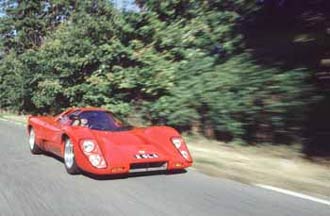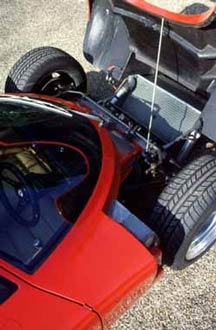| ATLAS F1 Volume 6, Issue 47 | |||
 |
Living a Dream | ||
| by Eoin Young; Photography by James Mann | |||
|
The McLaren F1 may be the world's greatest roadcar, but it wasn't the first supercar to emerge from the McLaren stable. Eoin Young caught up with an enthusiast who has painstakingly recreated a McLaren M6GT, Bruce McLaren's first attempt at a high-performance sportscar for the road
When McLaren Cars decided to build the ultimate road-going supercar back in the late 1980s, it was surely with team founder Bruce McLaren in mind. Although the legendary Kiwi had lost his life in a testing accident nearly 20 years before, the 240mph F1 that bears his name is the realisation of a dream which the young McLaren had nursed since the late 1960s.
With barely two years until that fateful June day in 1970 when Bruce lost control of one of his CanAm cars at Goodwood, it was no surprise that the M6GT project was still-born. In fact, only two cars ever made it off the production line; one was Bruce's own works prototype OBH 500H, now in the USA. The other was sold to British enthusiast David Prophet. Despite the rarity of the original M6GTs, half a dozen 'replicas' exist around the world.
Enter Nigel Hulme. A vintage car racer with a definite feel for big bangers – he has raced in Lola's fearsome T70 and AC's equally evil Cobra for many years – Nigel decided to lovingly replicate the M6GT in a style of which, he believes, Bruce would definitely approve.
"I think 'replica' is a misused word," says Hulme. "It really is a recreation of Bruce's first GT. We used the same recipe."
How did he decide on the ingredients?
"Well, it was Trojan, the firm responsible for producing McLaren's customer racing cars, that started the ball rolling. It offered a customer version of Bruce's successful M6 works race car; anyone who wanted to race the M6 in a private capacity could do so, thanks to Trojan. There were 28 of these cars, codenamed M6B, built as rolling chassis ready to accept a Chevrolet V8 or whatever engine the customer wanted."
"Now we have this car, and I really love the shape. It looks right from all angles. It looks new even in today's terms. It's like a modern car, yet it was built in 1968!"
The Hulmes, father and son, set about sourcing parts from the US and built the car over a five year period. "We imported a 5.7-litre Chevrolet engine because we wanted to have a unit that Bruce would have used in his roadcar. Plenty of torque, plenty of grunt..."
Jimmy Potton, who was a mechanic with Reg Parnell's F1 teams in the 1950s and 60s, did all the detail work on the Hulmes' M6GT, but he sadly died last year. Clive Robinson, from Specialised Mouldings, did the bodywork, tidying all the shut-lines so that it looked like a roadcar and not just a race car. Triplex remade the windscreen and the remaining perspex windows were sourced in the USA. Wheels were a major problem on the recreation. The M6 racing car had 17-inch rims on the back and 10-inch rims at the front. For the roadcar the Hulmes settled for 16-inch rims all round in order to get the correct rolling radius needed with modern road tyres.
"We used a bit of poetic licence when it came to interpreting the trim," confesses Hulme. "We opted for tan leather, brown carpets and red bodywork. The dashboard is trimmed in leather. The most important extra is the air-conditioning unit. It's a real hothouse without it, what with that 5.7-litre Chevrolet throbbing away just behind your head and the cramped cockpit. The air-con would almost certainly have been a high priority on Bruce's car, too."
The attention to detail on the car speaks for itself, but what is it like to drive?
"Terrific," Hulme responds. "It has loads of torque and the ZF gearbox is superb with its synchromesh and close ratios. The car has lovely road manners. It's docile but it's quick." Hulme thinks it would do about 180mph if pressed hard, but he doesn't sound anxious to try it. Must be something to do with the painstaking care and long man hours he's invested in recreating the dream of his boyhood hero.
Gordon Coppuck on the M6GT
M6GT designer Gordon Coppuck, now with the Arciero Wells ChampCar team in the USA, has clear memories of the days when he and Bruce McLaren were planning the GT version of their CanAm racer.
"Our original intention was to race the M6GT at Le Mans, but when the idea fell on deaf ears because of homologation problems, we started to think about a roadcar." McLaren and Coppuck went to Detroit for a meeting with General Motors styling chief Bill Mitchell, who arranged for Bruce to drive all their exotic roadcars on the GM test track. "Bruce came away convinced that there was nothing special about any of them. He thought we could do better ourselves. Back in Colnbrook we had a model of a GT body in the workshop and Bruce and I rubbed clay on it until we came up with a shape that we were happy with. We put a ZF gearbox in it and completed the car that winter of 1969/70.
"I borrowed the car one weekend and I took it for a Sunday morning drive to Bournemouth with my wife. It ran beautifully. It really was ridiculously fast for a roadcar at that time. It weighed the same as a Mini and had 10 times the power! The acceleration was spectacular and the shape drew crowds everywhere. It wasn't the easiest car to get in and out of and I remember it was the end of the miniskirt era and my wife was particularly shy of the onlookers around the car when we came out after lunch...."
Robin Herd remembers the M6 McLaren tests
Bruce McLaren recruited Robin Herd from the aerospace industry to head up his fledgling design department and it was Herd who designed the first monocoque McLaren M6 CanAm sports racer on which the M6GT was based. "It was actually an early ground-effect car," says Herd, recalling those early days with McLaren. "The M1 CanAm car tended to understeer so we put a strip under the nose and Bruce reported after tests that the understeer was reduced. He was always after an advantage. On the way down to Goodwood, we kicked ideas about to get negative pressure under the car. The top of the nose was made slightly concave to reduce the understeer. But more importantly we contoured the underside of the nose to create negative pressure and, we hoped, downforce.
"We knew we could get rear downforce with a wing but Teddy Mayer preferred a spoiler because he didn't want it to be thought that we were copying Jim Hall's Chaparral with its high wing.
"On the day of the big test to see if we had created negative pressure under the car, we went all high-tech with a half-inch rubber tube taped to the bottom of the car leading to an anemometer gauge – a pressure gauge – which I was holding. I had crammed myself into the passenger seat and Bruce was barrelling into the first corner at Goodwood. We seemed to be going a million miles per hour but it was probably 80 or 90, when the gauge suddenly registered negative pressure. I had rather hoped that Bruce would be concentrating on staying on the road, but he spotted the change on the gauge and started whooping and shouting and laughing and banging my arm. We'd cracked it!
"Bruce was in the queue for a Cosworth engine for Formula 1 in those days and he was anxious to do something interesting with his team. The idea was to get a commercial application for whatever we made,but it was more to do with having fun – and that's where the roadcar idea came from."
|
| Eoin Young | © 2000 Kaizar.Com, Incorporated. |
| Send comments to: comments@atlasf1.com | Terms & Conditions |
The article was prepared for Racing Line - McLaren's official magazine, and appears on Atlas F1 courtesy of TAG-McLaren Communications office | |
 Having dominated the 1967 CanAm 'big banger' sportscar series with the M6, Bruce wanted to take on the world's best at Le Mans – a race he'd already won for Ford – but met problems with homologation (the rules governing suitability of production cars for racing) and was forced to can the project. It was due to this disappointment that Bruce and his crew decided to pursue the roadcar angle.
Having dominated the 1967 CanAm 'big banger' sportscar series with the M6, Bruce wanted to take on the world's best at Le Mans – a race he'd already won for Ford – but met problems with homologation (the rules governing suitability of production cars for racing) and was forced to can the project. It was due to this disappointment that Bruce and his crew decided to pursue the roadcar angle.
 It was one of these M6B customer cars that Hulme found languishing in bits in North America. "It was missing some of its corners but it was fundamentally what my father and I were after, the basis on which we would build a road-going coupe similar to Bruce's original car. We found that Specialised Mouldings, the firm that created the glassfibre bodies for the M6 as well as other notable sports racers like the Lola T70 and Chevron B16, still had the original moulds. They kindly refurbished them for us, which really made the whole thing possible.
It was one of these M6B customer cars that Hulme found languishing in bits in North America. "It was missing some of its corners but it was fundamentally what my father and I were after, the basis on which we would build a road-going coupe similar to Bruce's original car. We found that Specialised Mouldings, the firm that created the glassfibre bodies for the M6 as well as other notable sports racers like the Lola T70 and Chevron B16, still had the original moulds. They kindly refurbished them for us, which really made the whole thing possible.
 The McLaren M6GT was clearly ahead of its time and it now seems, on reflection, rather a shame that such a hugely exciting vehicle was not given the chance to make as much of an impact as the later McLaren missile, the F1. Funny, too, that Bruce was actually embarrassed that the proposed price for his road car would be £6,000. Consider that the F1 costs more than 100 times that sum and you will agree, if we forget about inflation, that Bruce's M6GT would have been a monster performer and a monster bargain, too.
The McLaren M6GT was clearly ahead of its time and it now seems, on reflection, rather a shame that such a hugely exciting vehicle was not given the chance to make as much of an impact as the later McLaren missile, the F1. Funny, too, that Bruce was actually embarrassed that the proposed price for his road car would be £6,000. Consider that the F1 costs more than 100 times that sum and you will agree, if we forget about inflation, that Bruce's M6GT would have been a monster performer and a monster bargain, too.